Helston Railway
The Helston Railway is a heritage railway in Cornwall which aims to rebuild and preserve as much as possible of the former GWR Helston Railway between Nancegollen and Water-Ma-Trout on the outskirts of Helston. It is operated by the Helston Railway Preservation Company using members of the Helston Railway Preservation Society.
| The Helston Railway | |
|---|---|
 | |
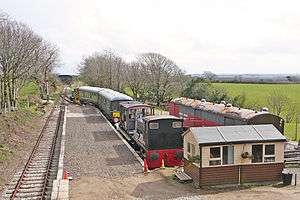 View of the now disused station at Trevarno in April 2010 | |
| Terminus | Helston railway station |
| Commercial operations | |
| Original gauge | 4 ft 8 1⁄2 in (1,435 mm) standard gauge |
| Preserved operations | |
| Stations | 2 |
| Length | 1.25 mi (2.0 km) |
| Preserved gauge | 4 ft 8 1⁄2 in (1,435 mm) standard gauge |
| Commercial history | |
| Closed to passengers | 1962 |
| Closed | 1964 |
| Preservation history | |
| 2010 | HR granted Light Railway Order |
| 2011 | HR re-opens |
| 2012 | HR relocates (upwards) into 'a nearby' Prospidnick |
| Headquarters | Prospidnick |
| Website | |
| Official website | |
The Helston Railway | ||||||||||||||||||||||||||||||||||||||||||||||||||||||||||||||||||||||||||||||||||||||
|---|---|---|---|---|---|---|---|---|---|---|---|---|---|---|---|---|---|---|---|---|---|---|---|---|---|---|---|---|---|---|---|---|---|---|---|---|---|---|---|---|---|---|---|---|---|---|---|---|---|---|---|---|---|---|---|---|---|---|---|---|---|---|---|---|---|---|---|---|---|---|---|---|---|---|---|---|---|---|---|---|---|---|---|---|---|---|
| ||||||||||||||||||||||||||||||||||||||||||||||||||||||||||||||||||||||||||||||||||||||
The Railway was a 8.5 miles (13.7 km) long 4 ft 8 1⁄2 in (1,435 mm) standard gauge railway branch line and is the southernmost branch line in the United Kingdom. It opened in 1887 and was absorbed by the Great Western Railway in 1898, continuing in existence as the Helston branch, and closing to passengers in 1962 and to goods in 1964.[1]
It was built to open up the agricultural district of south-west Cornwall, joining Helston to the main line railway network at Gwinear Road, between Penzance and Truro.
Its predominant business was agricultural, but in summer it carried holidaymakers, and its terminus at Helston was the railhead for a pioneering road connection service to the Lizard. During the Second World War there was considerable goods traffic at Nancegollan, sponsored by the Admiralty.
Original Railway
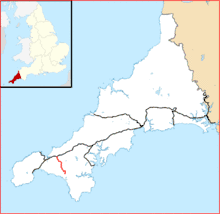
The line ran from Helston, in south-west Cornwall, to a junction with the main line of the Great Western Railway at Gwinear Road(50.1972°N 5.3475°W)(50.1070°N 5.2713°W). The connection there faced Penzance.
The line was 8 miles 67 chains (14.2 km) in length. As a purely local line running through difficult terrain, it was heavily curved and graded. Although Helston is an important town, most of the intermediate area was dedicated to agriculture, with little population, and the terminus at Helston was some distance from the seaside.
The main line at Gwinear Road gave direct access to London and the rest of England, on the route that is now known as the Cornish Main Line.
History
Before the advent of the railway, Helston was an important centre for tin and copper mining, as well as being the hub of an area of considerable agricultural production. Local businessmen observed the success that followed the opening of early railways elsewhere in Cornwall and further afield, and from 1825 a succession of schemes for tramroads and railways were put forward, many of them oriented towards Falmouth or Penryn and the River Fal estuary because of the harbour facilities there, (and, later, the arrival of the Cornwall Railway, enabling onward transport of minerals by coastal shipping). All of these schemes fell by the wayside due to the high cost of crossing the difficult terrain; after the collapse following the Railway Mania in the mid-1840s, money became increasingly scarce, and moreover the shallower seams in the mines began to become worked out, reducing the profitability of local mines.
In 1879, a rough survey was made of the proposed route and it was estimated that the railway could be constructed for £80,000, with the most expensive portion being a viaduct over the River Cober.[2] The Helston Railway Company was formed later that year, with a share capital of £70,000, with the object of building a standard gauge railway to Helston, not from the Falmouth area but from Gwinear Road on the West Cornwall line. The Great Western Railway was friendly towards this line, and they agreed to work the line when built.
The line received its Act of Parliament on 9 July 1880, and work was expected to start in the spring of 1881.[3] The first sod was cut at a ceremony on 22 March 1882 and it was hoped that the line would be completed in about eighteen months to two years. The intended stations were Praze, Nancegollan, Prospidnick and Helston.[4][5] In January 1883 the directors inspected the line, Prospidnick bridge was described as a massive granite structure 40 feet (12 m) high. Roads had to be diverted and new roads made and the estimated cost was nearly £1,000.[5]
Work proceeded but the original contractor found himself in difficulties early in 1884 and work stopped for a period, but was resumed under Lang & Son of Liskeard.
Even as late as 1886,[6] there was debate over the site of the Helston station; the site actually adopted, in Godolphin Road, was some distance to the east of the town centre. Some interests had proposed instead a location nearer the town; however the incremental cost would have been considerable and the proposal was finally dropped. The station was built as potentially a through station, with the idea of extension to the Lizard. This was revived from time to time, but was never acted upon.
The line was opened for the first service train on 9 May 1887.[6][7][8]
The line in action
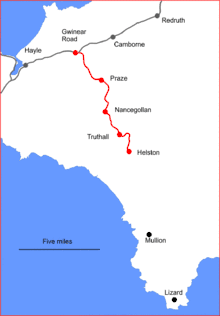
When the line was opened there were two intermediate stations at Praze (serving the villages of Praze-an-Beeble and Crowan) and Nancegollan. In 1905, Truthall Halt was opened close to the hamlet of Trannack and less than 2 miles (3 km) north of Helston.[9] There was also a ticket collecting platform just short of Helston until the end of 1902.[7]
The only significant structure on the line was the Cober Viaduct, more properly known as the Lowertown Viaduct, 373 feet (114 m) long and with six arches.[7]
Praze
Praze had only a single platform, 223 feet (68 m) long, on the up side of the line; there was a goods line formed as a loop, controlled by ground frame, on the down side.[6]
Nancegollan
Nancegollan Railway Station served an important agricultural district and also was the railhead for the fishing port of Porthleven. Originally it had a single passenger platform on the up side and a goods loop without a platform; the connections were operated by ground frame. In 1937 the facilities were considerably extended, with a full crossing facility for passenger trains and longer platforms on both lines, as well as a loop line behind the up platform and a large goods yard.[6]
In 1941, the station's goods sidings were further modified and extended in connection with airfield construction in the locality, and a new signal box with a lever frame that had been relocated from the Cornish Main Line at St Germans. A second, metal, bridge was also built at this time to carry the road over the new goods yard access lines.
Truthall Halt
A latecomer to the passenger facilities on the branch, Truthall Halt was opened on 3 July 1905, at a location about one and three-quarters miles (2.8 km) north of Helston;[10] it served the village of Trannack and also Truthall Manor. It was renamed Truthall Platform in July 1906 and reverted to Truthall Halt in the 1960s. Some tickets referred to it as Truthall Bridge Halt. It had a single platform 84 feet long on the down side of the line, though it was shortened later to about 50 feet.[6]
Helston
Laid out as a through station for the possible extension to the Lizard, Helston station had a single platform on the up side of the line; there was an engine release line, with goods facilities on the east side of the station. There was also a carriage shed for the two-coach branch train, and a single-road engine shed built in 1887, lasting until 1963.[6]
Helston station was much used by service personnel based at RNAS Culdrose from 1947.[6] The Royal Navy Air station is on the southern margin of Helston. If sufficient money had been given to extend to RNAS Culdrose, the line might have been saved.
Absorption by the Great Western Railway
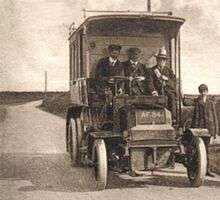
The line had been worked by the Great Western Railway from the outset, and on 1 July 1898 the line was vested in the GWR, the original Helston company being dissolved.[7]
The Great Western Railway operated a pioneering road passenger connection to Mullion and the Lizard from 17 August 1903, and a Porthleven connection was added in 1909, and surrounding villages were also served. There was also an extensive van service for goods traffic to and from the railway, developed into a motor lorry service from about 1925.[7]
A fragment of the GWR route map from about 1930 is given above, and shows several "road motor routes" radiating from Helston: there was a route to Porthleven and Breage; to Penhale (a small settlement east of Mullion, not the larger place near Indian Queens), Lizard and Lizard Point, and to Mullion; and Coverack and St Keverne, and to Manaccan; and to Falmouth and to Redruth.
The GWR formed a joint venture with the National Omnibus & Transport Company, forming the Western National Omnibus Company Ltd in 1929, and the GWR services were transferred to Western National. The GWR retained its shares in Western National until nationalisation of the railways in 1948.
Operation
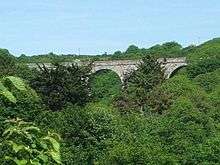
The branch was "uncoloured"—the lightest engine weight classification—but this was relaxed to permit 45XX 2-6-2T locomotives to operate, and these were the general motive power. 43XX 2-6-0s and 51XX 2-6-2Ts were allowed as far as Nancegollan only.[11] In the line's final years, Class 22 diesel locomotives were used to haul passenger and goods trains.
The line was single throughout, and several of the trains crossed at Nancegollan; from the opening of the passing loop there, the line was operated as two block sections, with signal boxes at Helston, Nancegollan and Gwinear Road East.
The line was sharply curved and steeply graded, with ruling gradients of 1 in 60 and 1 in 54.
In 1922, there were eight trains in each direction on the line; by 1939, this had been improved to ten (Monday to Friday) and eleven on Saturdays. The first train of the day started from Helston, as there was a small engine shed there.[12] The journey time was typically 25 minutes, and the general speed limit was 30 miles per hour (48 km/h)
Goods traffic on the branch was heavy, accounting for about two-thirds of the branch's revenue.[1] The primary traffic was agricultural, whist during the war years, and particularly during the D-Day preparations, Nancegollan saw extensive military traffic.
Local trains rarely ventured off the branch. In 1958, there were nine down and eight up trains Monday to Fridays; the last up train was formed of two sets of rolling stock, and two trains each way were mixed (passenger and goods). The 1.15 p.m. Helston to Gwinear Road had to be given special attention as it had a three-minute connection at Gwinear Road with the up Royal Duchy express for London. (The "up" direction was towards Gwinear Road.[6])
On Saturdays in that year there were fourteen down and eleven up trains, with three up trains running with double the stock. All of this was accomplished with two B-set two coach sets.
Closure
The branch was closed for passengers on 3 November 1962. Goods traffic continued for a further two years, finally ceasing on 4 October 1964; the track was lifted by mid-1965.[13]
Preservation
The original concept to re-open the branch was back in 1994 when Mart Hew from Helston and officials from British Rail, surveyed the line with the idea of a feasibility study. It was decided that due to the amount of work needed and the possible revenue that could be generated, it was not worth the effort and the project was dropped. In 2002 the Helston Railway Preservation Society was formed with about 12 members and on 28 April 2005, 40 years after the line was dismantled, work began clearing the overgrown vegetation.
The line was reopened for passengers in December 2011 for the Trevarno Gardens Winter Wonderland. As of November 2017 1 mile (1.6 km) of track had been relaid and is being used for public passenger rides from Prospidnick via Trevarno to Truthall Halt.[14]
The line is being rebuilt by volunteers and is funded by proceeds from passenger rides, donations and membership subscriptions, and by members who buy shares in the Helston Railway Company Ltd. Funds are also generated by the railway shop and a buffet. The Preservation Society gained Charity status in March 2012.
In 2016, planning permission was granted to extend the track and build new platforms and sidings at Prospidnick as well as to rebuild the halt at Truthall.[15] Truthall Halt was completed and reopened in November 2017.
In January 2018, calls have been made to reinstate the line as part of the National Rail network.[16]
Along the line
- Nancegollen – New site proposed, as old (original site) is now redeveloped.
- Trevarno Farm – New operational base and public car park
- It is proposed that a new station will be constructed at Trevarno Farm which will be opened.
- Prospidnick Halt – This is only a temporary platform and is current terminus of the Helston Railway, though this halt may close when the proposed Trevarno Farm, located just a little north of the halt, opens.
- Trevarno station (now request station) – This is one third of the way along the line and was until 21 October 2012 the main operational base of the Railway, and where passengers started their journeys. Now Passengers Access the station Via a Footbridge Known as Black Bridge this is off a public footpath.
- Truthall Halt
- Reopened 16 March 2017. Platform cleared, reconstructed and painstakingly restored to its former glory (Great Western style).
- Helston (Water-Ma-Trout)
- It is intended that the preserved line will eventually be restored "across the 4 arch Cober Viaduct" and right onto the outskirts of Helston (where a new and "permanent-replacement" station maybe proposed as the former Helston site itself now lies within private land and redevelopment), however this may take many years.
Current status
As of November 2017:
- The re-laid permanent way is now 1.25 miles (2.01 km) long from Prospidnick Halt to Truthall Halt.
- William Murdoch, an 0-4-0 Peckett steam shunting locomotive has been purchased and is undergoing restoration work. It should be operational by the spring 2018 season.
- Truthall Halt has been painstakingly rebuilt as an exact replica of the original halt.
- The Trevarno Estate was sold on 22 October 2012, having been purchased by a buyer who is using the estate as a private house. The railway now operates from a new temporary platform 540 yards up the line at Prospidnick. The railway has also constructed a new public car park 200 yards from the platform.
- The platform at Trevarno is now a request station but the sidings (now known as Tregadjack sidings) remain and will be used for storage of stock and some maintenance operations. An engine shed will also be constructed here.
- It is hoped that restoration will continue south within a few years to Water-Ma-Trout just near Helston; this would also include restoring the old Cober Viaduct.
As of April 2018, the Railway has secured the use of the Peckett 'Kilmersdon' for the 2018 season from the Somerset and Dorset Joint Railway Museum at Washford station. This Locomotive is Due To stay until Winter 2019/2020, when it will return to the Somerset and Dorset Railway Trust when the Boiler Ticket Expires and will be returned.[17] In August 2019, the Railway purchased a further quarter of a mile of trackbed past Truthall Halt and began clearance with the help of volunteers from RNAS Culdrose.[18]
Rolling stock
The line has thirteen rail vehicles on site: a two-car Park Royal (BR Class 103) DMU, a two-car Bed-Pan (BR Class 127) DMU, two Ruston & Hornsby 165DS 0-4-0 diesel shunters, a center car from a Pressed Steel (Class 117) DMU, A Mark 1 Suburban Brake, A R4 Peckett 0-4-0 ST, A R3 Peckett 0-4-0 ST, two BR 20 ton standard brake van, a Type 17A Wickham Trolley and two Flatbed Wagons. The Class 103, Class 117 and Rustons are owned by the Railway, With the R4 Peckett being owned by the Southall Railway Centre (and Portsmouth Council), R3 Peckett owned by the Somerset and Dorset Railway Trust, Mark 1 Suburban owned by the South Devon Railway and the Wickham Trolly owned by the Rail Trolley Trust. The rolling stock that is not owned by the Railway, are on either long or short-term loan.
Park Royal Class 103
HRDG's first purchase was a British Rail Class 103 DMU, one of only two left in preservation and the only one in a near-working condition. It has been protected by painting, but is not currently under restoration. When purchased from the West Somerset Railway, it was little more than a shell. It is currently in British Rail (BR) green livery. The individual cars are Driving Motor Brake Second (DMBS) 50143 and Driving Motor Lavatory Composite (DTCL) 56169. On 12 October 2008, one of the engines was started for the first time.
Ruston locomotive 327974
One of two Ruston shunter locomotives owned by the HRDG is number 327974. It has been restored, and has had a livery repaint into BR Blue. The locomotive is currently in use. It has been liveried with the number 97649.
Ruston locomotive 395305
The second of the Ruston 165DS 0-4-0 locomotives is build number 395305. It us out of service while its being vacuum brake fitted. It is currently painted in a pink livery due to a 2017 charity event.[19]
BR 20-ton standard brake van
HRDG's newest purchase is a BR 20-Ton Standard Brake van, B954673. It had been in a very poor state and has undergone major restoration works which were completed in November 2011; it is in brown. The van was put into use as soon as it was completed and is now carrying passengers on the line.
Rolling Stock Summary
| Number | Class | Image | Type | Livery | Status | Notes |
|---|---|---|---|---|---|---|
| 50143 | Class 103 | Diesel Multiple Unit (DMU), Driving coach | British Railways (BR) Green with Yellow warning panels | Static but in use as Staff Buffett and Waiting Room | ||
| 56169 | Class 103 | 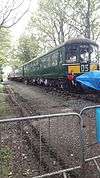 | DMU, Driving coach | BR Green with Yellow warning panels | Static but in use as a Buffet | |
| 59521 | Class 117 | 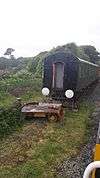 | DMU, Centre coach | BR Green one side, Brown and Cream on the other | Stored out of service, Under Occasional Long Term Maintenance.[20] | This coach has been vandalised, window smashed and graffitied on. Stripped of All Interior Features ready for repair. |
| 51616 | Class 127 |  |
DMU, Driving coach | BR Green with Speed Whiskers | Under Restoration | This unit arrived with 51622 from the Great Central Railway in January 2020.[21] |
| 51622 | Class 127 | DMU, Driving coach | BR Green with Speed Whiskers | Under Restoration | This unit arrived with 51616 from the Great Central Railway in January 2020.[21] | |
| 327974 liveried as 97649 | Ruston Class 165DS | 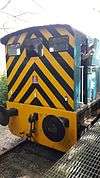 | Diesel Shunter 0-4-0 | BR Blue | In use | |
| 395305 | Ruston Class 165DS |  | Diesel Shunter 0-4-0 | Pink, due to a charity event in 2017.[22] | currently out of service while being vacuum brake fitted | |
| William Murdoch (W/No. 2100 of 1949) | Class R4 Peckett [23] | .jpg) | Industrial 0-4-0 Locomotive | Industrial Blue | Under Deep Overhaul | Property of Portsmouth Museums, on long-term loan to GWR Preservation Group Ltd, Repairs are replacing Boiler tubes after a Test failure. |
| Kilmersdon (W/No. 1788 of 1929) | Class R3 Peckett [23] |  | Industrial 0-4-0 Locomotive | SDJR Blue | In Occasional Usage | Property of Somerset and Dorset Railway Trust, on loan until Winter 2019/2020 when it will be returned once the Boiler Ticket is Out.[17] |
| Bluebell | BR 20-ton standard brake van | 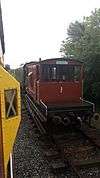 | Brake Van | BR Brown | In Use | |
| Daisy | BR 20-ton standard brake van | Brake Van | BR Brown with yellow middle section | Currently under Restoration | ||
| 94148 | BR General Utility Van | 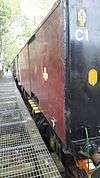 | GUV Coach NKA | Rail Express Systems Red | In Use | Shop. |
| E43147 | BR Mark 1 | .jpg) | British Railways Mark 1 Suburban Break | Carmine and Cream | In Use with Steam Locomotives | [24] |
| 188815 | Flatwagon | Black | Under Restoration | Gifted by the Sir Robert McAlpine Construction Company, Used T0 Build wembley Stadium. | ||
| Flatwagon | Black | Under Restoration | Gifted by the Sir Robert McAlpine Construction Company | |||
| 68016 | Type 17A Wickham Trolley | 2w-2PMR Petrol Mechanical Railcar | BR Marron | Under Restoration by the Junior Section volunteers[25] | On long-term loan from the Rail Trolley Trust at the Chasewater Railway. |
Steam working
On 25–26 July 2010, steam returned to Helston for the first time since 1962, during celebration of the completion of the latest station platform on the line and the newest since Truthall Platform in 1905.
The engine Judy,[26] one of two similar preserved Bagnall 0-4-0STs, lent a working presence, courtesy of Bodmin and Wenford Railway.
The Mayor of Helston officiated at the grand opening of Trevarno Station, on 26 July 2010, with Judy in attendance. Although Judy was in steam and operating on the railway, she was unable to carry passengers, as the company were not authorised to operate passenger trains at the time.
In March 2017, William Murdoch, an 0-4-0 Peckett shunting engine, was obtained on long-term loan from Portsmouth museum trust. It ran once down the line under its own steam but was quickly discovered to be in need of maintenance. The boiler has been overhauled with a new 10 year ticket and most maintenance work on the engine is complete. It is awaiting assembly.
For the 2018 and 2019 seasons, the Railway hired in R3 Peckett 'Kilmersdon' from the Somerset & Dorset Railway Trust at Washford. She is due to return to the S&DRT in 2020 for overhaul.[27]
See also
- Helston Folk Museum
References
- History of the Great Western Railway, vol II, MacDermot, E T, published by the Great Western Railway, London, 1932
- "Editorial". The Cornishman (54). 24 June 1879. p. 4.
- "Local News". The Cornishman (119). 21 October 1880. p. 7.
- "The Cutting Of The First Turf Of The Helston Railway". The Cornishman (193). 23 March 1882. p. 5.
- "Inspection Of The Helston Railway Works". The Cornishman (235). 11 January 1883. p. 6.
- Cornwall Railway Stations, Mike Oakley, 2009, Dovecote Press, Wimborne Minster, ISBN 978-1-904-34968-6
- The Hayle, West Cornwall and Helston Railways, Anthony G H, The Oakwood Press, Lingfield, 1968
- Robert Smith. "The Helston Branch". Retrieved 22 February 2009.
- The Railways of Great Britain, a Historical Atlas, Cobb, Col M H, Ian Allan Publishing Ltd, Shepperton, 2003
- http://www.cornwallrailwaysociety.org.uk/helston-branch.html
- Operation Cornwall, W S Becket, Xpress Publishing, Caernarvon, undated, ISBN 1-901056-25-2
- The Heyday of GWR Train Services, Semmens, P W B, David & Charles, Newton Abbot, 1990
- Atterbury, Paul (2011). Along Lost Lines. Cincinnati: David & Charles. p. 18. ISBN 978-0-7153-2706-7.
- "Track Map & Progress". Website of Helston Railway Preservation Company Ltd. Retrieved 2 September 2012.
- "News". Website of Helston Railway Preservation Company Ltd. Retrieved 2 August 2016.
- https://www.helstonrailway.co.uk/news/2018/sdjr-peckett-heads-for-cornwall/
- "Railway group makes further tracks to its destination". St Ives Times and Echo. 9 August 2019. p. 4.
- https://www.helstonrailway.co.uk/news/2018/pink-train-charity-day-raises-834-for-st-julias-hospice/
- "BR 59521 Class 117 DMU: Trailer Composite Lavatory built 1960". www.cs.vintagecarriagestrust.org. Retrieved 1 January 2018.
- "Diesel Multiple Units (DMU)". Helston Railway. Retrieved 17 January 2020.
- Harding, Ben (22 March 2018). "'PINK TRAIN' CHARITY DAY RAISES £834 FOR ST JULIA'S HOSPICE". Helston Railway. Retrieved 18 January 2020.
- Edgar, Gordon (2016). Industrial Locomotives & Railways of The South And West of England. Amberley Publishing. ISBN 978-1445649207.
- https://www.helstonrailway.co.uk/news/2018/a-br-mark-1-suburban-has-arrived/
- "Wickham 7594 Type 17A". www.railtrolleytrust.co.uk. Retrieved 17 January 2020.
- ""Judy" Bagnall 0-4-0 ST Built 1936". Cornish Steam Locomotive Preservation Society. Retrieved 14 July 2010.
- "Stock List : Somerset & Dorset Railway Trust". www.sdrt.org. Retrieved 17 January 2020.